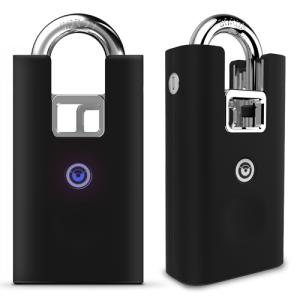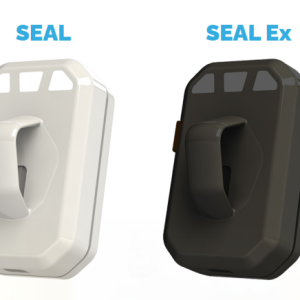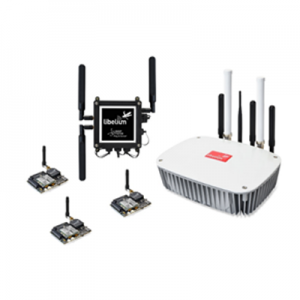IoT Weather Station
Descrição
Featuring LoRaWAN®
WTS Series
User Guide
Applicability
This guide is applicable to WTS series shown as follows, except where otherwise indicated.

Safety Precaution
Milesight will not shoulder responsibility for any loss or damage resulting from not following the
instructions of this operating guide.
- The device must not be disassembled or remodeled in any way.
- In order to protect the security of the device, please change device password when first
configuration. The default password is 123456. - The device is not intended to be used as a reference sensor, and Milesight will not should
responsibility for any damage which may result from inaccurate readings. - Do not place the device close to objects with naked flames.
- Do not place the device where the temperature is below/above the operating range.
- Make sure electronic components do not drop out of the enclosure while opening.
- When installing the battery, please install it accurately, and do not install the reverse or
wrong model. - Make sure both batteries are newest when install, or battery life will be reduced.
- The device must never be subjected to shocks or impacts.
Declaration of Conformity
WTS series is in conformity with the essential requirements and other relevant provisions of the
CE, FCC, and RoHS.

Copyright © 2011-2022 Milesight. All rights reserved.
All information in this guide is protected by copyright law. Whereby, no organization or individual
shall copy or reproduce the whole or part of this user guide by any means without written
authorization from Xiamen Milesight IoT Co., Ltd.

For assistance, please contact Milesight technical support:
Email: iot.support@milesight.com
Support Portal: support.milesight-iot.com
Tel: 86-592-5085280
Fax: 86-592-5023065
Address: Building C09, Software Park III, Xiamen 361024, China
Revision History
![]()
Contents

1. Product Introduction
1.1 Overvie
IoT Weather Station (WTS Series) is an all-in-one LoRaWAN® weather monitoring system for
various atmospheric conditions, such as temperature, humidity, wind speed, wind direction, barometric pressure and rainfall. Consisting of 3 main parts, WTS sensors, WTS Hub and solar
panel, IoT Weather Station is designed to withstand the most challenging weather conditions
and is easy to install in different scenarios to be widely used in meteorology, smart agriculture, smart building, etc.
Sensor data is transmitted using LoRaWAN® technology. Compliant with Milesight LoRaWAN® gateway and Milesight IoT Cloud solution, users can manage all sensor data and trigger other sensors or appliances easily via webpage or mobile App remotely.
1.2 Features
- Integrated with multiple sensors like humidity, temperature, barometric pressure, wind
speed, wind direction, rainfall, etc. - Waterproof, UV-proof and salt spray resistant enclosure for outdoor harsh environment
applications - High power solar powered with chargeable batteries backup
- Store locally more than 19,000 historical records and support retransmission to ensure no
data miss - Easy to carry and install
- Ultra-wide-distance wireless transmission up to the line of sight of 15 km in rural areas
- Equipped with NFC for easy and quick configuration
- Compliant with standard LoRaWAN® gateways and network servers
- Quick and easy management with Milesight IoT Cloud.
2. Hardware Introduction
2.1 Packing Lis


WTS505/WTS506 Only

![]() If any of the above items is missing or damaged, please contact your sales representative.
If any of the above items is missing or damaged, please contact your sales representative.
2.2 Dimensions(mm)
WTS Hub


WTS305

WTS505

WTS506

2.3 LED and Power Button
The LED indicator and power button are inside the WTS Hub device. Switch on/off and reset can
also be configured via NFC.

3. Operation Guide
3.1 NFC Configuration
WTS Hub can be configured via NFC. Before the configuration, please connect WTS Sensor to
the right interface of WTS Hub via sensor cable to read and test.
1. Download and install “Milesight ToolBox” App from Google Play or Apple Store.
2. Enable NFC on the smartphone and open“Milesight ToolBox” App.
3. Attach the smartphone with NFC area to the device to read basic information.

4. Basic information and settings of WTS Hub will be shown on ToolBox if it’s recognized
successfully. You can read and configure the device by tapping the buttons on the App. In order
to protect the security of devices, password validation is required when configuring via unused
phone . Default password is 123456.

Note:
1) Ensure the location of smartphone NFC area and it’s recommended to take off phone case.
2) If the smartphone fails to read/write configurations via NFC, keep the phone away and back
to try again.
3) WTS Hub can also be configured by dedicated NFC reader provided by Milesight IoT.
4) You can configure it via Type-C USB port inside the device by these steps: release the back
panel of WTS Hub and connect the device to computer via Type-C port, run ToolBox PC software, select serial port as USB port and type as “General”, then type password to login ToolBox and
configure the device. (Default password: 12345.

3.2 LoRaWAN Settiings
LoRaWAN settings is used for configuring the transmission parameters in LoRaWAN® network. Basic LoRaWAN Settings:
Go to “LoRaWAN -> Basic” of ToolBox software or “Setting -> LoRaWAN Settings” for ToolBox
App to configure join type, App EUI, App Key and other information. You can also keep all
settings by default.


Note:
1) Please contact sales for device EUI list if there are many units.
2) Please contact sales if you need random App keys before purchase.
3) Select OTAA mode if you use Milesight IoT Cloud to manage devices.
4) Only OTAA mode supports rejoin mode.
channels match the LoRaWAN® gateway.

If the frequency is one of CN470/AU915/US915, you can enter the index of the channel that you
want to enable in the input box, making them separated by commas.
Examples:
1, 40: Enabling Channel 1 and Channel 40
1-40: Enabling Channel 1 to Channel 40
1-40, 60: Enabling Channel 1 to Channel 40 and Channel 60
All: Enabling all channels
Null: Indicates that all channels are disabled.

Note:
For -868M model, default frequency is EU868;
For -915M model, default frequency is AU915;
3.3 Basic Settings
Go to “Device Settings -> Basic” of ToolBox software or “Device->Setting->General Settings” of ToolBox App to change the reporting interval, etc.


![]()
3.4 Advanced Settings
3.4.1 Data Storage
WTS series sensor supports storing more than 19,000 data records locally and exports data via
ToolBox App or ToolBox software. The device will record the data according to reporting interval
even not joining to network.
1. Go to “Device Settings -> Basic” of ToolBox software or “Device -> Settings -> General
Settings” of ToolBox App to enable data storage feature.
2. Go to “Maintenance -> Basic” of ToolBox software or “Device -> Maintenance” of ToolBox
App, click “Export”, then select the data time period and click “Save” to export data.
Note: Toolbox App can only export last 7 days’ data. If you need to export more data, please use
ToolBox software.
3. Click “ Clear” to clear all stored data inside the devices.

3.4.2 Data Retransmission
WTS Series sensor supports data retransmission to ensure network sever can get all data even if
network is down for some times. There are two ways to get the lost data:
- Network server sends downlink commands to enquire the historical data for specifying time range, refer section 5.4
- When network is down if no response from LinkCheckReq MAC packets for a period of time, the device will record the network disconnected time and re-transmit the lost data after
device re-connects the network.Here are the steps for data retransmission:
1. Ensure the device time is correct, please use Toolbox software or ToolBox App to sync the
time

If you set LoRaWAN® version as 1.0.3 or 1.1, the network server will use MAC commands to
assign the time to device every time when the sensor joins to network.
2. Enable data storage feature and data retransmission feature.

3. Enable rejoin mode feature and set the number of packets sent. Take below as example, the
device will send LinkCheckReq MAC packets to the network server at least every 30 minutes to
check if the network is disconnected. If there is no response for 4 times (4*30 minutes = 120
minutes = 2 hours), device network status will change to de-activated and the device will record
a data lost time point(disconnection time minus 2 hours).
Note: If the reporting interval is less than 30 minutes, the time = packets sent * 30 minutes; if the
reporting interval is more than 30 minutes, the time = packets sent * reporting interval.

4. After the network connected back, the device will send the lost data from the point in time
when the data was lost according to the reporting interval.
Note:
1) If the device is reboot or re-powered when data retransmission is not completed, the device
will re-send all retransmission data again after device is reconnected to the network.
2) If the network is disconnected again during data retransmission, it will only send the latest
disconnection data.
3) The retransmission data format is started with “20ce”, please refer to section 5.4.
4) Data retransmission will increase the uplinks and shorten the battery life.
3.5 Maintenance
3.5.1 Upgrade
ToolBox Software :
1. Download firmware from Milesight website to your PC.
2. Run Toolbox App, go to “Maintenance > Upgrade”, click “Browser” to import the firmware and
upgrade the firmware.

ToolBox App:
1. Download firmware from Milesight website to your smartphone.
2. Open Toolbox App and click “Browse” to import firmware and upgrade the device.
Note:
1) It is not supported to do any operation on ToolBox during upgrading.
2) Only Android version ToolBox App supports upgrade feature.

3.5.2 Backup
WTS Hub devices support configure backup for easy and quick device configuration in bulk. Backup is allowed only for devices with the same model and LoRaWAN® frequency band.
1. Go to “Template” page on the App and save current settings as a template. You can also edit
the template file.
2. Select one template file which saved in the smartphone and click “Write”, then attach to
another device to write configuration.

Note: Slide the template item left to edit or delete the template. Click the template to edit the
configurations.

3.5.3 Reset to Factory Default
Please select one of following methods to reset device:
Via Hardware: Hold on power button (internal) of WTS Hub for more than 10s.
Via ToolBox App: Go to “Device->Maintenance” to click “Reset”, then attach smart phone with
NFC area to WTS Hub to complete reset.

4. Installation
4.1 Installation Locations
- Within the communication range of LoRaWAN® gateway.
- No high buildings or barriers (trees, telegraph poles) around; the distance between the IoT
weather station and the nearest obstacle is preferably 10 times the height of the obstacle. - Keep away from radars, transmitters and any other instruments which can generate
electrical interference; keep a distance of more than 2 meters between sensor and radar. - Keep away from heat sources like chimney, vents, etc.
- No fence plants (higher than 1m) around weather station within 10m.
4.2 Solar Panel and WTS Hub Installation
1. Fix the hub mounting bracket to the solar panel bracket with 4 fixing screws, the put the WTS
Hub to the bracket fix the bottom of hub to the bracket with a fixing screw.

2. Adjust the angle of solar panel brackets (20°,40° or 60°is optional) according to the
installation environment, then fix the two sides of bracket with screw kits.

3. Straighten the hose clamps and slide them through the rectangular rings in the solar panel’s
bracket, wrap the hose clamps around the pole. After that use a screwdriver to tighten the
locking mechanism by turning it clockwise.

4. Connect the cable of solar panel to left interface of WTS Hub.

4.3 WTS305 Sensor Installation
1. Loose the flange base of sensor and connect one side of sensor cable to the sensor and
tighten the cable, then screw the flange base back to the sensor.

2. Connect the sensor to the pole top flange with nuts and bolts, then connect the other side of
sensor cable o the right interface of WTS Hub. When installing, ensure the arrow on the sensor
facing north according to a compass. Users can install the sensor with other installation
methods by selecting other accessories.

4.4 WTS505/WTS506 Sensor Installation
1. Connect the bent pipe to the mounting bracket, tighten the 2 hex socket cap screws with
screwdriver and tighten the insurance screw by hand to ensure the two parts are fixed well.

2. Connect one side of sensor cable to WTS Sensor and tighten the cable, pass the cable
through the bent pipe and bracket, then connect the pipe to the bottom of sensor and fix both
parts with 3 hex socket cap mounting screws.

3. Straighten the hose clamps and slide them through the rings in the bracket, wrap the hose
clamps around the pole. After that use a screwdriver to tighten the locking mechanism by
turning it clockwise. When installing, ensure the arrow on the sensor facing north according to a
compass.

4. Connect the other side of sensor cable to the right interface of WTS Hub.

5. Device Payload
All data are based on following format (HEX), the Data field should follow little-endian:

For decoder examples please find files on https://github.com/Milesight-IoT/SensorDecoders.
5.1 Basic Information
WTS series sensors report basic information of sensor whenever joining the network.

Example:

5.2 Sensor Data
WTS series report sensor and battery data according to reporting interval (10min by default).


Example:
1. WTS305

2. WTS506


5.3 Downlink Commands
WTS series sensors support downlink commands to configure the device. The application port is
85 by default.

Example:
1. Set reporting interval as 20 min

2. Reboot

3. Set time zone to GMT-4

4. Set the device time

5.4 Historical Data Enquiry
WTS series support sending downlink commands to enquire historical data for specified time
point or time range. Before that, ensure the device time is correct and data storage feature was
enabled to store the data.
Command format:


Reply format:

Note:
1. The device only uploads no more than 300 data records per range enquiry. 2. When enquiring the data in time point, it will upload the data which is closest to the search
point within the reporting interval range. For example, if the device’s reporting interval is 10
minutes and users send command to search for 17:00’s data, if the device find there is data
stored in 17:00, it will upload these data. If no, it will search for data between 16:50 to 17:10 and
upload the data which is closest to 17:00.
Example:
1. Enquire historical data between 2022/10/10 14:45:00 to 2022-10-10 15:00.

Reply:

![]()

Produtos relacionados
-

Controle Acesso Sem Chave Sera4
O produto já setá na lista de cotação. -

SEAL
O produto já setá na lista de cotação. -

Insertion Temperature Sensor
O produto já setá na lista de cotação. -

Gateway e Sensores Libelium
O produto já setá na lista de cotação.







Avaliações
Não há avaliações ainda.